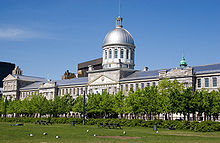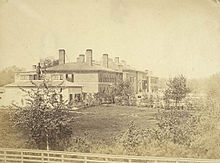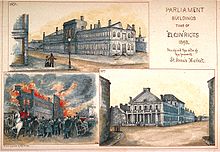
The Province of Canada was a British colony in British North America from 1841 to 1867. Its formation reflected recommendations made by John Lambton, 1st Earl of Durham, in the Report on the Affairs of British North America following the Rebellions of 1837–1838.

The Legislative Assembly of Ontario is the legislative chamber of the Canadian province of Ontario. Its elected members are known as Members of Provincial Parliament (MPPs). Bills passed by the Legislative Assembly are given royal assent by the lieutenant governor of Ontario to become law. Together, the Legislative Assembly and Lieutenant Governor make up the unicameral Legislature of Ontario or Parliament of Ontario. The assembly meets at the Ontario Legislative Building at Queen's Park in the provincial capital of Toronto.

The First Ontario Parliament Buildings were built between 1829 and 1832 near Front, John, Simcoe and Wellington Streets in what was then York, Upper Canada. They served as the parliament buildings for Upper Canada, the Province of Canada, and the province of Ontario after Canadian Confederation in 1867.

The Legislative Council of Upper Canada was the upper house governing the province of Upper Canada. Modelled after the British House of Lords, it was created by the Constitutional Act of 1791. It was specified that the council should consist of at least seven members. Members were appointed for life but could be dropped for non-attendance. The first nine members of the council were appointed on 12 July 1792. The speaker was usually the Chief Justice of the Court of King's Bench. The Legislative Council was dissolved on 10 February 1841 when Upper and Lower Canada were united into the Province of Canada. Some members were reappointed to the Legislative Council of the united Province.

The First Parliament of the Province of Canada was summoned in 1841, following the union of Upper Canada and Lower Canada as the Province of Canada on February 10, 1841. The Parliament continued until dissolution in late 1844.
The 3rd Parliament of the Province of Canada was summoned in 1848, following the general election for the Legislative Assembly in January 1848. The first session was held at Montreal, Canada East. In 1849, rioters protesting the Rebellion Losses Bill burned the parliament buildings. The remaining sessions were held in Toronto. The Parliament was dissolved on November 6, 1851.
The 4th Parliament of the Province of Canada was summoned in December 1851, following the general election for the Legislative Assembly in October 1851. Sessions were held in Quebec City. The Parliament was dissolved in June 1854.
The 8th Parliament of the Province of Canada was summoned in August 1863, following the general election for the Legislative Assembly in August 1863. The Parliament was abolished when the British North America Act, 1867 came into force on July 1, 1867, creating the new country of Canada.
The Legislative Council of the Province of Canada was the upper house for the Province of Canada, which consisted of the former provinces of Lower Canada, then known as Canada East and later the province of Quebec, and Upper Canada, then known as Canada West and later the province of Ontario. It was created by The Union Act of 1840. With the lower house, the Legislative Assembly of the Province of Canada, the two houses constituted the Parliament of the Province of Canada.
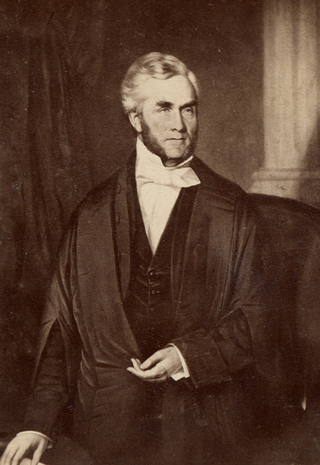
James Morris was a businessman, banker and political figure in Canada West. He was a member of the Legislative Assembly of the Province of Canada, as a Reformer. He was later a member of the Legislative Council, serving as the Speaker of the Legislative Council. He was also a member of the Executive Council of the province.

Sir Henry Smith was a Canadian lawyer and political figure. He represented Frontenac County in the Parliament of the Province of Canada, and later in the 1st Parliament of Ontario.
The Executive Council of the Province of Canada had a similar function to the Cabinet in England but was not responsible to the Legislative Assembly of the Province of Canada from its inception in 1841 to 1848.
David Morrison Armstrong was a merchant, insurance agent and political figure in Canada East in the Province of Canada. He represented the electoral district of Berthier in the Legislative Assembly of the Province of Canada from 1841 to 1851. From 1855 to 1867 he sat in the Legislative Council of the Province of Canada, and in the Legislative Council of Quebec from 1867 until his death. He initially opposed the union of the Lower Canada and Upper Canada into the Province of Canada, and supported the reform movement for responsible government. After responsible government was achieved, he gradually became a Conservative.
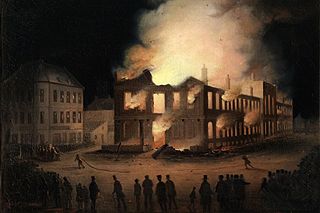
The burning of the Parliament Buildings in Montreal was an important event in pre-Confederation Canadian history and occurred on the night of April 25, 1849, in Montreal, the then-capital of the Province of Canada. It is considered a crucial moment in the development of the Canadian democratic tradition, largely as a consequence of how the matter was dealt with by then co-prime ministers of the united Province of Canada, Sir Louis-Hippolyte Lafontaine and Robert Baldwin.
There are currently fourteen legislative buildings in Canada: Parliament in Ottawa, and one for each of the provinces and territories of Canada, though not all contain the words legislative building in their names.

The Parliament of the Province of Canada was the legislature for the Province of Canada, made up of the two regions of Canada West and Canada East.
Bytown was an electoral district of the Legislative Assembly of the Parliament of the Province of Canada. The district represented the town of Bytown, in Canada West, which was re-named Ottawa in 1855. The electoral district was created in 1841, upon the establishment of the Province of Canada, from the merger of Upper Canada and Lower Canada. It was renamed to Ottawa following the renaming of the city.
Dundas was an electoral district of the Legislative Assembly of the Parliament of the Province of Canada, in Canada West, on the north shore of the Saint Lawrence River east of Lake Ontario. It was created in 1841, upon the establishment of the Province of Canada by the union of Upper Canada and Lower Canada.
Frontenac was an electoral district of the Legislative Assembly of the Parliament of the Province of Canada, in Canada West, based on Frontenac County. It was created in 1841, upon the establishment of the Province of Canada by the union of Upper Canada and Lower Canada. Frontenac was represented by one member in the Legislative Assembly. It was abolished in 1867, upon the creation of Canada and the province of Ontario.
